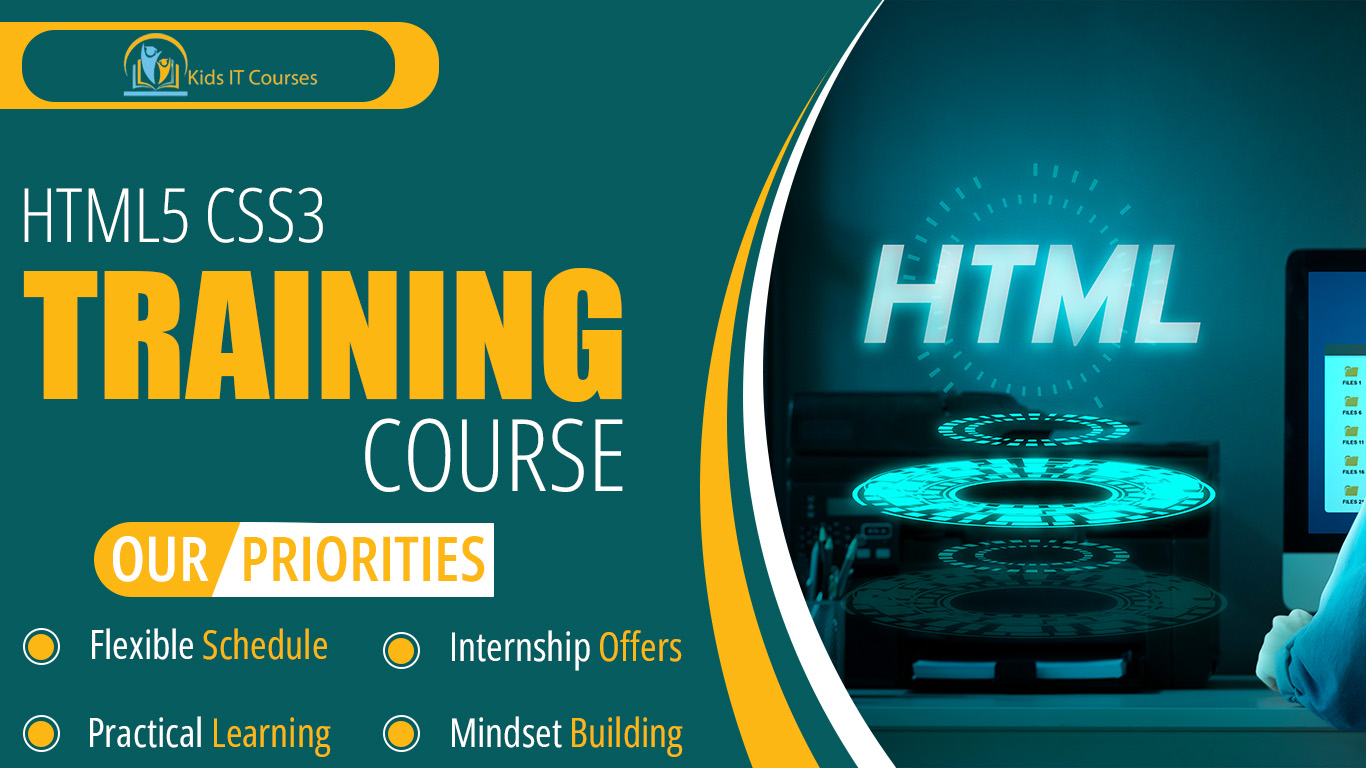
HTML5 & CSS3 Course for Kids
Definition
• HTML5 makes website structure. It tells what goes where.
• CSS3 makes websites beautiful. It adds colors and styles.
• Kids can make web pages. With text, pictures, and videos.
• HTML5 is like the body. CSS3 is like the clothes.
• Kids learn coding basics. In a fun and easy way.
• Websites work on all devices. Phones, tablets, and computers.
• Kids feel proud and happy. They build their own sites.
Importance
• HTML5 builds the website’s base. It gives the page its shape.
• CSS3 makes the website pretty. It adds colors and styles.
• Kids can make web pages. Fun and easy to learn.
• They learn to design layouts. Pages look neat and clear.
• Websites work on all devices. Phones, tablets, and computers.
• It builds creativity in kids. They enjoy making designs.
• Learning helps in the future. It’s a skill for many jobs.
Advantages for Freelancing
• Kids can make their own websites. It feels fun and creative.
• HTML5 builds the page. CSS3 makes it look nice.
• Kids learn to add colors. And choose cool fonts.
• Websites can work on phones. And also on computers.
• Kids can add pictures. And even fun videos.
• They can change designs fast. Just by editing the code.
• It helps them think smart. And solve problems easily.
Session 1 : Introduction to HTML5
What is HTML and how it structures web pages
Real-life example: A book’s table of contents (structure of a page)
The difference between HTML4 and HTML5
Basic HTML tags:
<html>,<head>,<body>,<h1>,<p>Activity: Create a simple webpage with a heading and paragraph
Session 2 : HTML5 Elements and Semantics
What are semantic HTML tags and why they matter
Real-life example: Organizing books into categories (semantics)
Common HTML5 elements:
<header>,<footer>,<article>,<section>Activity: Build a webpage using semantic elements
Session 3 : HTML Forms and Input Types
Creating forms and inputs in HTML
Real-life example: Filling out a survey form
Different types of input elements: text, radio buttons, checkboxes
HTML5 form validation attributes
Activity: Build a contact form with input fields and validation
Session 4 : Introduction to CSS3
What is CSS and how it styles HTML elements
Real-life example: Painting a house (styling a webpage)
The difference between inline, internal, and external CSS
Basic CSS selectors, properties, and values
Activity: Apply styles to your HTML page using CSS
Session 5 : Layouts and Positioning with CSS
Understanding the box model: padding, border, margin
Real-life example: Organizing furniture in a room
CSS positioning: static, relative, absolute, fixed
Using
display,float, andflexboxfor layoutsActivity: Create a simple 2-column layout using CSS
Session 6 : Responsive Design and Media Queries
What is responsive design and why it’s important
Real-life example: Adjusting a map to fit a mobile screen
Introduction to media queries for different screen sizes
Building a responsive layout using percentages and media queries
Activity: Make your page responsive for mobile and desktop
Session 7 : CSS3 Transitions, Animations, and Effects
What are CSS transitions and animations?
Real-life example: A door opening smoothly (transition)
How to animate elements using CSS keyframes
Adding hover effects for interactive pages
Activity: Create a button with hover effects and a smooth animation
Session 8 : Final Project – Build a Fully Styled Web Page
Plan and build a complete webpage using HTML5 and CSS3
Create a layout, apply styles, make it responsive
Test your page on different devices
Activity: Present your final project, explaining the design choices
Bonus Materials
HTML5 & CSS3 cheat sheet
Responsive design best practices guide
Link to free online CSS frameworks like Bootstrap
Interactive quizzes and coding challenges
Certificate of Completion for HTML5 & CSS3 Basics
